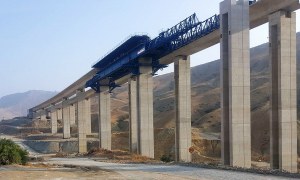🕑 Reading time: 1 minute
Contents:
- Different Methods of Bridge Construction
- 1. Cast-in-situ Method of Bridge Construction
- 2. Balanced Cantilever Method of Bridge Construction
- 3. Precast Method of Bridge Construction
- 4. Span by Span Casting method of Bridge Construction
- 5. Incremental Launching Method of Bridge Construction
- 6. Cable-Stayed Method of Bridge Construction
- 7. Arch Method for Bridge Construction
- Factors Affecting Selection of Bridge Construction Methods
Different Methods of Bridge Construction
Described below are the different methods employed in the construction of bridges.1. Cast-in-situ Method of Bridge Construction
This method is a flexible method of bridge construction where complex and unusual geometrical shapes of dams can be constructed easily. Situations when it is hard to transport pre-fabricated elements either due to size or unreachability, this method is a good choice. Read More: Cast-in-situ Method of Bridge Construction2. Balanced Cantilever Method of Bridge Construction
This method is used for constructing bridges with span 50 to 250m. The bridge constructed can either be cast-in-place or precast. Here, the segments are attached in an alternative manner at opposite ends of the cantilevers supported by piers. This is the best choice for the construction of long span length bridges, irregular length, and cable-stayed bridges.
Fig.1: Balanced Cantilever Bridge Construction; Image Courtesy: www.fpscmalaysia.com
3. Precast Method of Bridge Construction
In this method, the bridge is constructed with the help of precast concrete elements. The prefabrication is performed in different methods. The precast elements include:- Precast Beams
- Precast Decks
- Precast Segmental Decks

Fig.2: Precast method of bridge construction
4. Span by Span Casting method of Bridge Construction
This method is associated with cantilever construction method but with many advancements in the technique, it is considered as most economic and rapid in construction. For long bridges and viaducts with an individual span up to 60m, the method is feasible. Decks are begun at one abutment and constructed continuously by placing segments to the other end of the bridge. Segments can be positioned by either a temporary staying mast system through more commonly using an assembly truss. Read More: Span by Span Casting method of Bridge Construction5. Incremental Launching Method of Bridge Construction
The Incremental Launching Method (ILM) method of bridge construction is employed mainly for the construction of continuous concrete bridges or steel girder bridges. The method performs the procedure in increments. With this method of construction, the bridge deck is built in sections by pushing the structure outwards from an abutment towards the pier. The ILM method can be used for bridge decks with a length greater than 250m.
Fig.3:Incremental Launching Method of Bridge Construction;Image Courtesy:www.fcp.at
6. Cable-Stayed Method of Bridge Construction
In the cable-stayed method of construction, cables are used to carry the bridge deck from one or both sides of the supporting tower. The cables carry and transfer all the loads to the foundations. Cable-stayed method of construction is used for constructing bridges that span more than 300m. Read More: Cable Stayed Method of Bridge Construction7. Arch Method for Bridge Construction
Arch shaped bridge construction is one of the most economical choices when the bridge under consideration is required to cross over landscapes that are inaccessible. Many modern arch construction methods have made the arch construction more economical. The arch construction can be built with concrete or pre-cast concrete. The cast-in-situ free cantilever method and slip formed sections are two main construction techniques coming under arch methods. Read More: Arch Method for Bridge ConstructionFactors Affecting Selection of Bridge Construction Methods
Before a bridge can be built an appropriate method of construction must be chosen. The decision is made by the design team. The principle factors considered by the design team when choosing a suitable method of construction are given below:- The scale of the bridge
- The obstacles to be crossed
- The regularity of the span lengths
- The horizontal and vertical profiles of the bridge decks
- The nature of the soil strata
- The local weather
- The local cost of materials
- The local labor markets
- The accessibility of the site
- The time allowed for construction.


